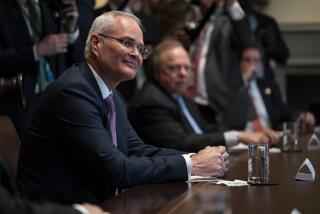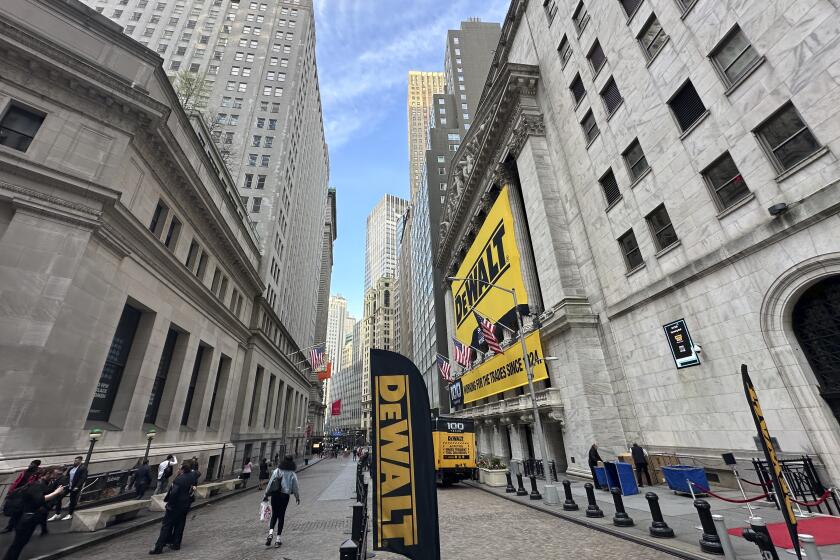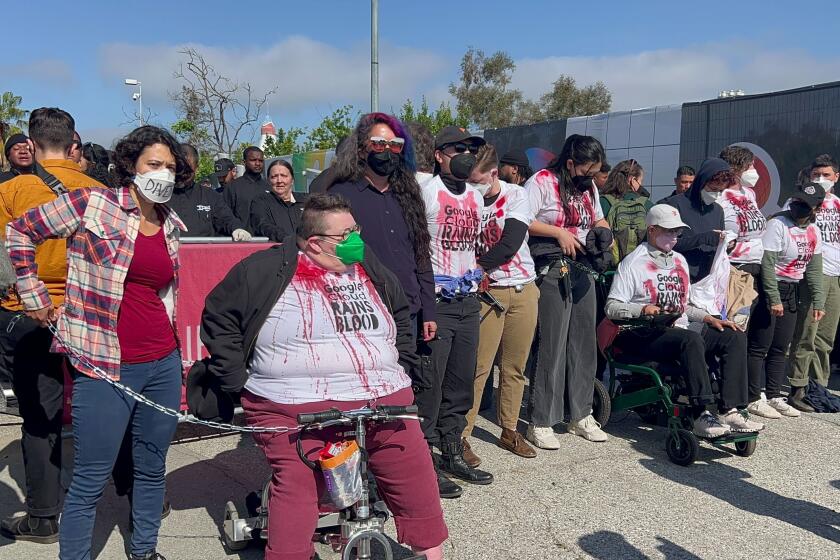Vegas Ride’s Safety Questioned : Flyaway Runs Into a Bit of Turbulence
Marvin Kratter is not a man to shrink from hyperbole.
The 69-year-old entrepreneur once credited a Romanian “youth drug,” which Kratter manufactured and sold in Nevada, with curing his depression and saving his life.
He later predicted that an abandoned gold field in Northern California, in which he had a controlling interest, would become a “mini-Venice,” featuring luxury home sites nestled along 24 miles of waterways. It hasn’t, yet.
But Kratter, who is bald, bearded and portly, is even more enthusiastic about his latest venture--a two-story “flying chamber” in which, for a $10 fee, would-be adventurers can don a billowy jump suit and, buoyed by gale-force winds churned up by a recessed airplane propeller, soar up to 22 feet in the air.
“I think it’s the greatest sensation that a man can have. . . .,” Kratter exulted. “It’s what I call the three E’s--euphoria, elation and escape.”
Kratter wants to bring his flight chamber--he calls it Flyaway--to Southern California, where a passion for offbeat pastimes holds out the promise of large profits.
Earlier this year, he received permission to sell Flyaway franchises in California. But sales efforts have been hampered by questions about Flyaway’s safety.
Kratter withdrew a $3-million stock offering that was to have financed a Los Angeles franchise after the offering attracted only about $8,000 in investments. Kratter blamed the poor response on “overly cautious” California Department of Corporations officials, who insisted that he fully disclose safety questions raised about Flyaway in Nevada lawsuits.
More than two dozen lawsuits filed in Las Vegas in the last two years contend that Kratter’s flying machine is dangerous. According to figures that Flyaway attorneys filed with California authorities, more than 250 patrons have been hurt in the flight chamber since it opened in December, 1982.
The precise number of injuries is in dispute, but court records indicate at least 53 patrons have dislocated shoulders or knees, while 18 say they have broken arms, legs, ankles or backs.
For example, Mark R. Grundman, a 23-year-old fireman from El Centro, Calif., was on his honeymoon in October, 1983, when he tried to fly. Despite padded walls and floors, Grundman said he broke two vertebrae when he drifted out of the upward air current and crashed. He was in a back brace--and out of work--for more than a month.
Furthermore, contends Jonathan C. Reed, a Las Vegas attorney who represents a dozen clients who have filed suits against Flyaway, patrons are not adequately informed of the dangers involved.
Sign Revision Claimed
Since the first lawsuits were filed, Reed said, Kratter has revised a large sign painted across the top of the Flyaway building on Convention Center Drive, east of the Las Vegas Strip near the Stardust Hotel and Casino.
The sign used to say: “You Can Safely Fly Like a Bird.” The word “Safely” now reads, “Surely.”
Kratter bristles at the suggestion that his machine is unsafe.
“In my opinion, we have a better safety record than any participatory sport that I know of,” he said, “such as skiing, water skiing, ice skating, roller skating, tobogganing, some of the water parks.”
Whatever risks Flyaway poses are fully disclosed, he added, both by Flyaway instructors and in a detailed release form patrons are required to sign before they enter the flight chamber.
Millions in Real Estate
Kratter is not the type to give up in the face of a challenge, legal or otherwise. After an unsuccessful stint as an Arizona dude ranch operator, Kratter in the early 1950s returned to his native New York and in 20 years amassed a multimillion-dollar fortune, largely through innovative real estate deals. He moved to Las Vegas in 1974, coming out of retirement to take over two companies--one that manufactured Gerovital, the “youth drug,” and a second that sought to exploit old gold fields near Yuba City, Calif. He has since relinquished control of both but remains an investor.
The allegations concerning Flyaway’s safety have not hurt business, Kratter said. But he is concerned, he said, because he envisions Flyaway’s future extending far beyond the Las Vegas desert.
Wants to See 100
“I’d like to see a hundred of them, 50 in the United States and 50 in the rest of the world,” Kratter said. Each franchise has a price tag ranging from $100,000 to $500,000. Each chamber costs $1.25 million to build.
Since Flyaway opened in Las Vegas, it has drawn 150,000 visitors and the attention of a national audience, largely through the enthusiastic accounts of such television programs as “P.M. Magazine,” “Two on the Town” and “Eye on L.A.”
Typically, the Flyaway segments show an apprehensive television personality zipping himself into an oversized jump suit, which is designed to provide additional lift. After 15 minutes or so of instruction, provided by live spotters and a videotape, the TV host climbs into the flight chamber, standing on two layers of steel mesh that cover a DC-3 airplane propeller.
Powered by an 800-horsepower electric motor, the propeller whips up a 120-m.p.h. wind that lifts the flier into the air. A net at the top restricts the flight to 22 feet. When he emerges, the TV aeronaut is invariably exhausted--and awe-struck.
Last fall, Kratter sold his first Flyaway franchise. A Japanese businessman paid $500,000 for the right to build 19 flight chambers in that country. Kratter himself bought the worldwide rights more than three years ago from inventors in Canada and California.
Despite his success in Japan, Kratter failed in a recent attempt to sell stock in a California company that would have set up and operated a Flyaway franchise in Los Angeles.
According to a prospectus filed with the California Department of Corporations, Kratter and others had hoped to raise up to $3 million through a public stock offering to capitalize Flyaway Los Angeles Corp.
Only $8,000 Invested
When the offering was withdrawn in early June, Flyaway Los Angeles had attracted only 25 investors who put up a total of about $8,000.
Kratter would say only that the offering failed because of “. . . the overly cautious disclosures that I was required and compelled to make by the corporation commissioner’s office of California. . . .”
According to Ernest W. Kapes, a senior counsel in the department’s Los Angeles office: “One of the things that concerned us here was the safety aspect of this. This is a plan of business that we felt did present some risks that people could be injured.”
Susan Wood, also a counsel with the corporations department, asked Kratter to delete a reference to Flyaway’s “excellent safety record” from promotional materials he planned to use.
“We felt that in view of the litigation, that there might be a question,” she said. Flyaway’s most public battle over the safety issue has been with Reed and other attorneys who have filed lawsuits against Kratter, Flyaway and related corporations.
“I believe Flyaway is a very dangerous activity,” Reed said in an interview. To support that view, Reed has referred in lawsuits to the list of injuries Flyaway filed with the California Department of Corporations.
Between early March, 1983, and late October, 1984, according to the injury list compiled by Flyaway attorneys, 150 patrons sprained their ankles, backs, shoulders, necks, arms, legs, hips or wrists. Another 53 reported dislocated shoulders and knees. Forty-four said they suffered cuts and bruises, while seven said they sustained minor miscellaneous injuries. Only three fractures were reported.
That list, however, includes only those injuries that have not become the subject of lawsuits. Lawsuits assert that as many as 18 other people have suffered broken bones inside the flight chamber.
Comparison Called Difficult
Despite those numbers, Kratter said that Flyaway is no more dangerous than most recreational sports.
However, comparing the injury rates at Flyaway with those of other recreational activities is a tricky business, said Robert E. Frye, director of the hazard analysis division of the U.S. Consumer Product Safety Commission.
For example, using the commission’s injury figures and its own attendance estimate, the International Assn. of Amusement Parks and Attractions said the rate of emergency-room treated injuries at so-called fixed-site amusement attractions in 1983 was about 2 for every 100,000 park visitors.
According to its own figures, Flyaway’s injury rate is about 250 for every 100,000.
But Kratter contends that comparisons with amusement parks are unfair.
Compared to Sports
“Most amusement attractions are passive. You sit on a merry-go-round, and the horse goes around; that’s an amusement attraction,” Kratter said. Flyaway more closely resembles sports such as snow skiing, water skiing, ice skating and roller skating, he said.
“I just believe that having had 150,000 people through here and have 29 lawsuits or whatever the number is, that the percentage is extremely low. . . . You’ve got a better chance of getting hurt in a basketball game,” he said.
Frye said figures that would allow a meaningful comparison of Flyaway’s injury record with those of participatory sports are not readily available.
“The whole question of exposure to a product needs to be considered,” Frye said. “If you are only exposed to, say, a ride for 10 minutes and the injury rate is a certain frequency, that’s one question. You may be exposed to your bicycle for two hours, and the injury rate is different.”
Many of the lawsuits filed by Reed and other attorneys allege that Flyaway managers have deliberately concealed the risk of injury from customers by ordering employees to play down the dangers. The suits also assert that Flyaway customers are inadequately trained, supervised and protected and that Flyaway managers crowd too many patrons into the flying chamber at one time.
Angered by Accusations
The accusations anger Kratter.
Flyaway instructors are extensively trained, Kratter said, and the 15-minute videotape shown to patrons more than adequately prepares them for the flying experience. While as many as five people may be in the flying chamber at once, only one person at a time is actually in the air, Kratter said.
Far from concealing the risks associated with the flight chamber, Flyaway has bent over backward to alert customers that they may be hurt, Kratter said. Employees are told to make no statements about safety, he said, but to refer prospective fliers to the release form they are required to both sign and initial.
“The release speaks for itself,” Kratter said. “Anybody who comes in here is in effect making a contract with us. He is saying that I recognize I might be hurt, you told me so and if I’m hurt I won’t look to you. . . .”
Nevada judges so far have taken differing views of that claim. One judge affirmed the right of a plaintiff to sue who acknowledged that she had signed the release. Another judge dismissed a case on the strength of the release argument. That decision is being appealed.
“It hurts to find yourself subjected, because of the existing legal system, to (this) kind of publicity,” Kratter said.
“I learned a long time ago that no matter how right you are or how moral you are or how justified you are, it doesn’t always come out that way. . . .”






